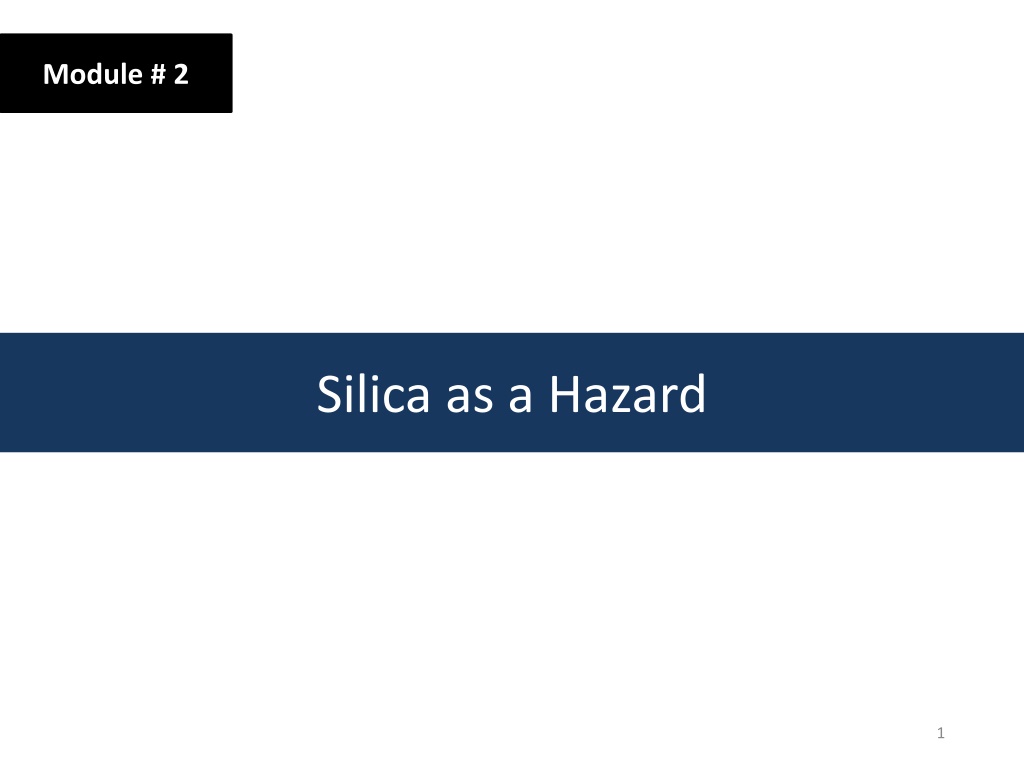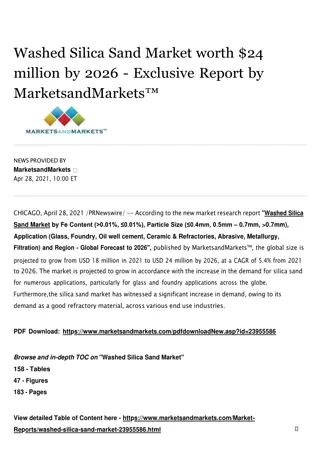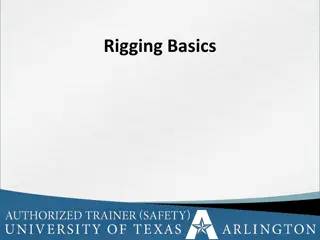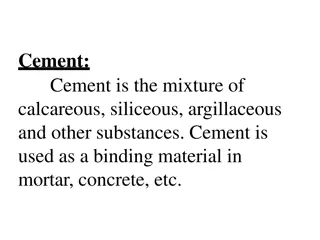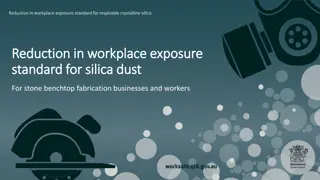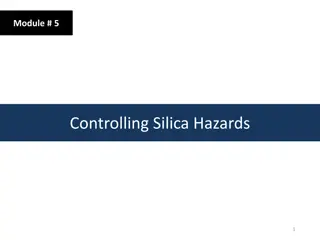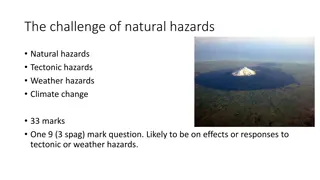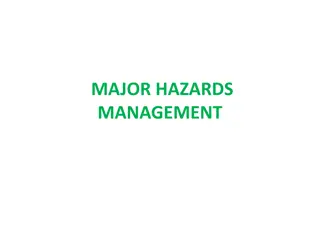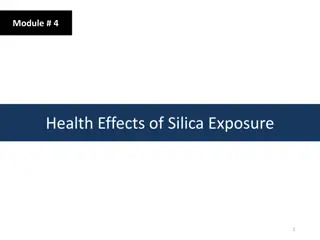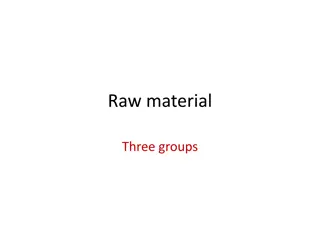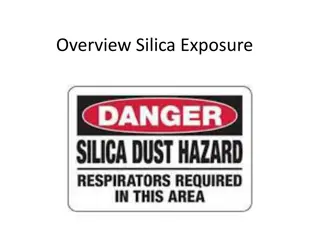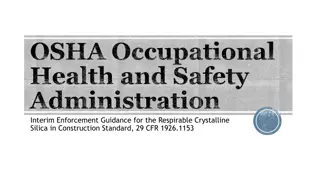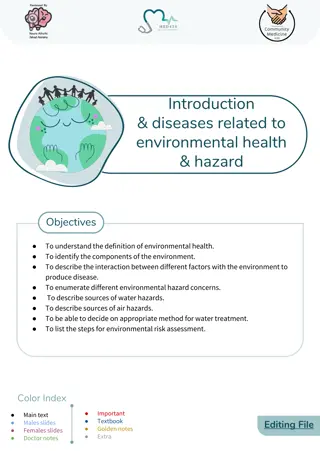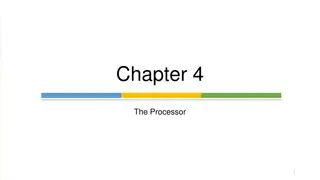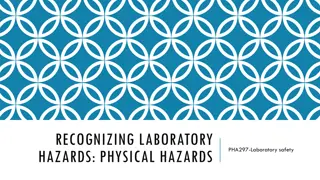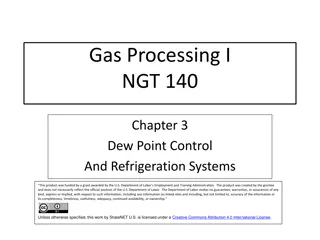Silica Hazards in Construction Materials
Silica is a common hazard in construction materials, with around 2.3 million workers exposed to airborne silica dust. This dust can lead to silicosis and other lung diseases, posing health risks based on exposure levels and duration. Regulations like the permissible exposure limit (PEL) and time-weighted average (TWA) help mitigate these risks by setting boundaries for safe exposure levels.
Download Presentation

Please find below an Image/Link to download the presentation.
The content on the website is provided AS IS for your information and personal use only. It may not be sold, licensed, or shared on other websites without obtaining consent from the author.If you encounter any issues during the download, it is possible that the publisher has removed the file from their server.
You are allowed to download the files provided on this website for personal or commercial use, subject to the condition that they are used lawfully. All files are the property of their respective owners.
The content on the website is provided AS IS for your information and personal use only. It may not be sold, licensed, or shared on other websites without obtaining consent from the author.
E N D
Presentation Transcript
Module # 2 Silica as a Hazard 1
Disclaimer This material was produced under grant number SH-05053-SH8 from the Occupational Safety and Health Administration, U.S. Department of Labor. It does not necessarily reflect the views or policies of the U.S. Department of Labor, nor does mention of trade names, commercial products, or organizations imply endorsement by the U.S. Government. 2
Silica as a Hazard (1) Silica is found in many construction materials such as concrete, dimension stone, soil, and landscaping materials. Roughly 2.3 million workers are exposed to airborne silica dust that is created by cutting, grinding, or drilling these materials. 3
Silica as a Hazard (2) Airborne silica dust is hazardous because: Silica dust causes Silicosis which increases the probability of a variety of lung diseases Silica dust particles are very small (You can t see them) Early exposure may go unnoticed The probability of getting sick depends on the amount of dust, and the frequency (i.e., the length of time) of the exposure. 4
Silica as a Hazard (3) The risk of sickness from silica dust increases as exposure to it increases The permissible exposure limit (PEL) is 50 micrograms of respirable crystalline silica per cubic meter ( g/m3) over an 8-hour work day (TWA) The action level is 25 g/m3 which initiates certain required activities such as exposure monitoring and medical surveillance. 5
Silica as a Hazard (4) Perspective on PEL 50 ( g/m3) = 1.41 ( g/ft3) = 1000/700 ( g/ft3) 700 ft3 1000 g 6
Silica as a Hazard (5) Perspective on Time Weighted Average (TWA) TWA is the highest level of exposure an employee may be exposed to without incurring the risk of adverse health effects. 50 g/m3 over an 8-hour work day Your exposures may increase and decrease throughout an 8-hour work day, you may be exposed while performing a silica-generating task to more than 50 g/m3 and then not receive additional exposures. TWA tells your average exposure which may be below or above 50 g/m3 for each 8-hour work shift. 7
Silica as a Hazard (6) Remember: Early exposure may go unnoticed which makes silica a hazard that is hard to identify. 8
Example for Time Weighted Average (TWA) (1) Considering the following information, please calculate the employee's exposure (8 hour TWA). Sample Sampling Period (minutes) Total Volume (m3) Weight of Dust (mg) Concentra tion (mg/m3) A 288 0.405 0.855 2.1 B 192 0.326 0.619 1.9 Total 480 0.731 1.474 Exposure = [(mg/m3(1) time(1)) + (mg/m3(2) time(2)) + ... + (mg/m3(n) time(n))] 480 minutes 9
Example for Time Weighted Average (TWA) (2) Considering the following information, please calculate the employee's exposure (8 hour TWA). Sample Sampling Period (minutes) Total Volume (m3) Weight of Dust (mg) Concentra tion (mg/m3) A 288 0.405 0.855 2.1 B 192 0.326 0.619 1.9 Total 480 0.731 1.474 Exposure = = [(2.1 238) + (1.9 192)] 480 = 1.8 mg/m3 10
Review & Questions Name three important things you learned in this section. 11
